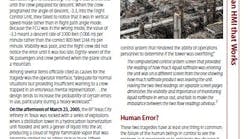At 6:20 on the evening of Jan 20, 1992, an Airbus A32 took off from Lyon, France on a regularly scheduled domestic flight to Strasbourg. The flight was uneventful until the crew prepared for descent. When the crew programed the angle of descent, -3.3, into the Flight Control Unit, they failed to notice that it was in vertical speed mode rather than in flight path angle mode. Because the FCU was in the wrong mode, the value of -3.3 meant a descent rate of 3300 feet (1006 m) per minute rather than the correct 800 feet (244 m) per minute. Visibility was poor, and the flight crew did not notice the error until it was too late. Eighty-seven of the 96 passengers and crew perished when the plane struck a mountain.Among several items officially cited as causes for the tragedy was the operator interface, "adequate for normal situations but providing insufficient warning to a crew trapped in an erroneous mental representation. The design tends to increase the probability of certain errors in use, particularly during a heavy workload."
Latest in HMI
Latest in HMI
Sponsored Content
Sept. 12, 2024


